Giant squid: Difference between revisions
| [pending revision] | [pending revision] |
No edit summary |
No edit summary |
||
| Line 41: | Line 41: | ||
}} |
}} |
||
The '''giant squid''' ([[genus]]: '''''Architeuthis''''') is a |
The '''giant squid''' ([[genus]]: '''''Architeuthis''''') is a deep-ocean dwelling [[squid]] in the [[family (biology)|family]] '''Architeuthidae''', represented by as many as eight [[species]]. Giant squid can grow to a tremendous size (see [[Deep-sea gigantism]]): recent estimates put the maximum size at {{convert|13|m|ft|abbr=on}} for females and {{convert|10|m|ft|abbr=on}} for males from [[Fish anatomy|caudal fin]] to the tip of the two long tentacles (second only to the [[colossal squid]] at an estimated {{convert|14|m|ft|abbr=on}},<ref>Anderton, H.J. 2007. [http://replay.waybackmachine.org/20100523152104/http://www.beehive.govt.nz/node/28451 Amazing specimen of world's largest squid in NZ]. New Zealand Government website.</ref> one of the [[largest organisms|largest living organisms]]). The [[Mantle (mollusc)|mantle]] is about {{convert|2|m|ft|abbr=on}} long (more for females, less for males), and the length of the squid excluding its tentacles is about {{convert|5|m|ft|abbr=on}}. Claims of specimens measuring {{convert|20|m|ft|abbr=on}} or more have not been scientifically documented. |
||
On 30 September 30 2004, researchers from the [[National Science Museum of Japan]] and the [[Ogasawara Whale Watching Association]] took the first images of a live giant squid in its natural habitat.<ref name=first>Kubodera, T. & K. Mori 2005. {{PDFlink|1=[http://rspb.royalsocietypublishing.org/content/272/1581/2583.full.pdf First-ever observations of a live giant squid in the wild.]}} ''Proceedings of the Royal Society B: Biological Sciences'', '''272'''(1581):2583–2586.</ref> Several of the 556 photographs were released a year later. The same team successfully filmed a live adult giant squid for the first time on 4 December 2006.<ref>{{cite news |url=http://news.nationalgeographic.com.au/news/2006/12/061222-giant-squid.html |title=Photo in the News: Giant Squid Captured, Filmed for First Time |author=de Pastino, Blake |date=December 22, 2006 |work=National Geographic News |accessdate=September 20, 2011}}</ref> |
On 30 September 30 2004, researchers from the [[National Science Museum of Japan]] and the [[Ogasawara Whale Watching Association]] took the first images of a live giant squid in its natural habitat.<ref name=first>Kubodera, T. & K. Mori 2005. {{PDFlink|1=[http://rspb.royalsocietypublishing.org/content/272/1581/2583.full.pdf First-ever observations of a live giant squid in the wild.]}} ''Proceedings of the Royal Society B: Biological Sciences'', '''272'''(1581):2583–2586.</ref> Several of the 556 photographs were released a year later. The same team successfully filmed a live adult giant squid for the first time on 4 December 2006.<ref>{{cite news |url=http://news.nationalgeographic.com.au/news/2006/12/061222-giant-squid.html |title=Photo in the News: Giant Squid Captured, Filmed for First Time |author=de Pastino, Blake |date=December 22, 2006 |work=National Geographic News |accessdate=September 20, 2011}}</ref> |
||
Revision as of 18:31, 9 November 2012
| Giant squid | |
|---|---|
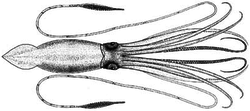
| |
| Giant squid, Architeuthis sp., modified from an illustration by A.E. Verrill, 1880 | |
| Scientific classification | |
| Kingdom: | |
| Phylum: | |
| Class: | |
| Subclass: | |
| Order: | |
| Suborder: | |
| Family: | Architeuthidae Pfeffer, 1900
|
| Genus: | Architeuthis Steenstrup in Harting, 1860
|
| Species | |
| |

| |
| Worldwide giant squid distribution based on recovered specimens | |
| Synonyms | |
| |
The giant squid (genus: Architeuthis) is a deep-ocean dwelling squid in the family Architeuthidae, represented by as many as eight species. Giant squid can grow to a tremendous size (see Deep-sea gigantism): recent estimates put the maximum size at 13 m (43 ft) for females and 10 m (33 ft) for males from caudal fin to the tip of the two long tentacles (second only to the colossal squid at an estimated 14 m (46 ft),[1] one of the largest living organisms). The mantle is about 2 m (6.6 ft) long (more for females, less for males), and the length of the squid excluding its tentacles is about 5 m (16 ft). Claims of specimens measuring 20 m (66 ft) or more have not been scientifically documented.
On 30 September 30 2004, researchers from the National Science Museum of Japan and the Ogasawara Whale Watching Association took the first images of a live giant squid in its natural habitat.[2] Several of the 556 photographs were released a year later. The same team successfully filmed a live adult giant squid for the first time on 4 December 2006.[3]
Morphology and anatomy
Like all squid, a giant squid has a mantle (torso), eight arms, and two longer tentacles (the longest known tentacles of any cephalopod). The arms and tentacles account for much of the squid's great length, making it much lighter than its chief predator, the sperm whale. Scientifically documented specimens have masses of hundreds, rather than thousands, of kilograms.

The inside surfaces of the arms and tentacles are lined with hundreds of subspherical suction cups, 2 to 5 cm (0.79 to 1.97 in) in diameter, each mounted on a stalk. The circumference of these suckers is lined with sharp, finely serrated rings of chitin.[4] The perforation of these teeth and the suction of the cups serve to attach the squid to its prey. It is common to find circular scars from the suckers on or close to the head of sperm whales that have attacked giant squid. Each arm and tentacle is divided into three regions – carpus ("wrist"), manus ("hand") and dactylus ("finger").[5][6] The carpus has a dense cluster of cups, in six or seven irregular, transverse rows. The manus is broader, close to the end of the arm, and has enlarged suckers in two medial rows. The dactylus is the tip. The bases of all the arms and tentacles are arranged in a circle surrounding the animal's single, parrot-like beak, as in other cephalopods.

Giant squid have small fins at the rear of their mantles used for locomotion. Like other cephalopods, they are propelled by jet – by pulling water into the mantle cavity, and pushing it through the siphon, in gentle, rhythmic pulses. They can also move quickly by expanding the cavity to fill it with water, then contracting muscles to jet water through the siphon. Giant squid breathe using two large gills inside the mantle cavity. The circulatory system is closed, which is a distinct characteristic of cephalopods. Like other squid, they contain dark ink used to deter predators.

The giant squid has a sophisticated nervous system and complex brain, attracting great interest from scientists. It also has the largest eyes of any living creature except perhaps colossal squid – over 30 cm (1 ft) in diameter. Large eyes can better detect light (including bioluminescent light), which is scarce in deep water. The giant squid probably cannot see colour, but it can probably discern small differences in tone, which is important in the low-light conditions of the deep ocean.[7]
Giant squid and some other large squid species maintain neutral buoyancy in seawater through an ammonium chloride solution which flows throughout their bodies and is lighter than seawater. This differs from the method of flotation used by most fish, which involves a gas-filled swim bladder. The solution tastes somewhat like salmiakki[citation needed] and makes giant squid unattractive for general human consumption.
Like all cephalopods, giant squid use organs called statocysts to sense their orientation and motion in water. The age of a giant squid can be determined by "growth rings" in the statocyst's "statolith", similar to determining the age of a tree by counting its rings. Much of what is known about giant squid age is based on estimates of the growth rings and from undigested beaks found in the stomachs of sperm whales.
Size
The giant squid is the second-largest mollusc and the second largest of all extant invertebrates. It is only exceeded by the colossal squid, Mesonychoteuthis hamiltoni, which may have a mantle nearly twice as long. Several extinct cephalopods, such as the Cretaceous vampyromorphid Tusoteuthis,[8] the Cretaceous coleoid Yezoteuthis,[9] and the Ordovician nautiloid Cameroceras[10] may have grown even larger.
Giant squid size, particularly total length, has often been exaggerated. Reports of specimens reaching and even exceeding 20 m (66 ft) are widespread, but no animals approaching this size have been scientifically documented.[11] According to giant squid expert Steve O'Shea, such lengths were likely achieved by greatly stretching the two tentacles like elastic bands.[11]

Based on the examination of 130 specimens and of beaks found inside sperm whales, giant squids' mantles are not known to exceed 2.25 m (7.4 ft).[11] Including the head and arms, but excluding the tentacles, the length very rarely exceeds 5 m (16 ft).[11] Maximum total length, when measured relaxed post mortem, is estimated at 13 m (43 ft) for females and 10 m (33 ft) for males from caudal fin to the tip of the two long tentacles.[11]
Giant squid exhibit sexual dimorphism. Maximum weight is estimated at 275 kg (606 lb) for females and 150 kg (330 lb) for males.[11]
Reproductive cycle
Little is known about the reproductive cycle of giant squid. They are thought to reach sexual maturity at about three years old; males reach sexual maturity at a smaller size than females. Females produce large quantities of eggs, sometimes more than 5 kg (11 lb), that average 0.5 to 1.4 mm (0.020 to 0.055 in) long and 0.3 to 0.7 mm (0.012 to 0.028 in) wide. Females have a single median ovary in the rear end of the mantle cavity and paired, convoluted oviducts, where mature eggs pass exiting through the oviducal glands, then through the nidamental glands. As in other squid, these glands produce a gelatinous material used to keep the eggs together once they are laid.
In males, as with most other cephalopods, the single, posterior testis produces sperm that move into a complex system of glands that manufacture the spermatophores. These are stored in the elongate sac, or Needham's sac, that terminates in the penis from which they are expelled during mating. The penis is prehensile, over 90 cm (35 in) long, and extends from inside the mantle.
How the sperm is transferred to the egg mass is much debated, as giant squid lack the hectocotylus used for reproduction in many other cephalopods. It may be transferred in sacs of spermatophores, called spermatangia, which the male injects into the female's arms. This is suggested by a female specimen recently found in Tasmania, having a small subsidiary tendril attached to the base of each arm.
Postlarval juveniles have been discovered in surface waters off New Zealand, with plans to capture more and maintain them in an aquarium to learn more about the creature.[12]
Ecology
Feeding

Recent studies have shown giant squid feed on deep-sea fish and other squid species.[13] They catch prey using the two tentacles, gripping it with serrated sucker rings on the ends. Then they bring it toward the powerful beak, and shred it with the radula (tongue with small, file-like teeth) before it reaches the esophagus. They are believed to be solitary hunters, as only individual giant squid have been caught in fishing nets. Although the majority of giant squid caught by trawl in New Zealand waters have been associated with the local hoki (Macruronus novaezelandiae) fishery, hoki do not feature in the squid's diet. This suggests giant squid and hoki prey on the same animals.[13]
Predators
Adult giant squids' only known predators are sperm whales, but pilot whales may feed on them, also.[14][15] Juveniles are preyed on by deep-sea sharks[16] and other fish. Because sperm whales are skilled at locating giant squid, scientists have tried to observe them to study the squid.
Range and habitat
Giant squid are very widespread, occurring in all of the world's oceans. They are usually found near continental and island slopes from the North Atlantic Ocean, especially Newfoundland, Norway, the northern British Isles, Spain and the oceanic islands of the Azores and Madeira, to the South Atlantic around southern Africa, the North Pacific around Japan, and the southwestern Pacific around New Zealand and Australia.[17] Specimens are rare in tropical and polar latitudes.
The vertical distribution of giant squid is incompletely known, but data from trawled specimens and sperm whale diving behaviour suggest it spans a large range of depths, possibly 300–1000 m.[18]
Species
The taxonomy of the giant squid, as with many cephalopod genera, has not been resolved. Lumpers and splitters may propose as many as eight species or as few as one. The broadest list is:
- Architeuthis dux, Atlantic giant squid
- Architeuthis hartingii
- Architeuthis japonica
- Architeuthis kirkii
- Architeuthis martensi, North Pacific giant squid
- Architeuthis physeteris
- Architeuthis sanctipauli, southern giant squid
- Architeuthis stockii

These are probably not distinct species. No genetic or physical basis for distinguishing between them has been proposed, as evidenced by the place names – of location of specimen capture – used to describe several of them. The rarity of observations of specimens and the extreme difficulty of observing them alive, tracking their movements, or studying their mating habits militates against a complete understanding.
In the 1984 FAO Species Catalogue of the Cephalopods of the World, Roper, et al. wrote:[19]
"Many species have been named in the sole genus of the family Architeuthidae, but they are so inadequately described and poorly understood that the systematics of the group is thoroughly confused."
Nesis (1982) considered only three species were likely to be valid.[20]
In 1991, Frederick Aldrich of the Memorial University of Newfoundland wrote:[21]
"I reject the concept of 20 separate species, and until that issue is resolved, I choose to place them all in synonymy with Architeuthis dux Steenstrup."
In a letter to Richard Ellis dated 18 June 18 1996, Martina Roeleveld of the South African Museum wrote:[21]
"So far, I have seen nothing to suggest that there might be more than one species of Architeuthis."
In Cephalopods: A World Guide (2000), Norman writes:[22]
"The number of species of giant squid is not known, although the general consensus amongst researchers is that there are at least three species, one in the Atlantic Ocean (Architeuthis dux), one in the Southern Ocean (A. sanctipauli) and at least one in the northern Pacific Ocean (A. martensi)."
Timeline

Aristotle, who lived in the fourth century BC, already described a large squid, which he called teuthus, distinguishing it from the smaller squid, the teuthis. He mentions, "of the calamaries, the so-called teuthus is much bigger than the teuthis; for teuthi [plural of teuthus] have been found as much as five ells long."[23]
Pliny the Elder, living in the first century AD, also described a gigantic squid in his Natural History, with the head "as big as a cask", arms 30 ft (9.1 m) long, and carcass weighing 700 lb (320 kg).[21][24][25]
Tales of giant squid have been common among mariners since ancient times, and may have led to the Norse legend of the kraken, a tentacled sea monster as large as an island capable of engulfing and sinking any ship. Japetus Steenstrup, the describer of Architeuthis, suggested a giant squid was the species described as a sea monk to the Danish king Christian III circa} 1550. The Lusca of the Caribbean and Scylla in Greek mythology may also derive from giant squid sightings. Eyewitness accounts of other sea monsters like the sea serpent are also thought to be mistaken interpretations of giant squid.
Steenstrup wrote a number of papers on giant squid in the 1850s. He first used the term "Architeuthus" (this was the spelling he chose) in a paper in 1857. A portion of a giant squid was secured by the French gunboat Alecton in 1861, leading to wider recognition of the genus in the scientific community. From 1870 to 1880, many squid were stranded on the shores of Newfoundland. For example, a specimen washed ashore in Thimble Tickle Bay, Newfoundland on 2 November 1878; its mantle was reported to be 6.1 m (20 ft) long, with one tentacle 10.7 m (35 ft) long, and it was estimated as weighing 2.2 tonnes. In 1873, a squid "attacked" a minister and a young boy in a dory in Bell Island, Newfoundland. Many strandings also occurred in New Zealand during the late 19th century.
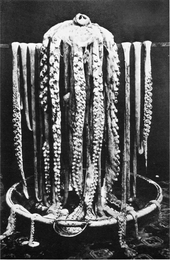
Although strandings continue to occur sporadically throughout the world, none have been as frequent as those at Newfoundland and New Zealand in the 19th century. It is not known why giant squid become stranded on shore, but it may be because the distribution of deep, cold water where squid live is temporarily altered. Many scientists who have studied squid mass strandings believe they are cyclical and predictable. The length of time between strandings is not known, but was proposed to be 90 years by Architeuthis specialist Frederick Aldrich. Aldrich used this value to correctly predict a relatively small stranding that occurred between 1964 and 1966.
In 2004, another giant squid, later named "Archie", was caught off the coast of the Falkland Islands by a fishing trawler. It was 8.62 m (28.3 ft) long and was sent to the Natural History Museum in London to be studied and preserved. It was put on display on 1 March 2006 at the Darwin Centre.[26][27][28] The find of such a large, complete specimen is very rare, as most specimens are in a poor condition, having washed up dead on beaches or been retrieved from the stomachs of dead sperm whales.
Researchers undertook a painstaking process to preserve the body. It was transported to England on ice aboard the trawler; then it was defrosted, which took about four days. The major difficulty was that thawing the thick mantle took much longer than the tentacles. To prevent the tentacles from rotting, scientists covered them in ice packs, and bathed the mantle in water. Then they injected the squid with a formol-saline solution to prevent rotting. The creature is now on show in a 9-m (20-ft) glass tank at the Darwin Centre of the Natural History Museum.

In December 2005, the Melbourne Aquarium in Australia paid A$100,000 for the intact body of a giant squid, preserved in a giant block of ice, which had been caught by fishermen off the coast of New Zealand's South Island that year.[27]
The number of known giant squid specimens was close to 600 in 2004,[29] and new ones are reported each year. The search for a live Architeuthis specimen includes attempts to find live young, including larvae. The larvae closely resemble those of Nototodarus and Onykia, but are distinguished by the shape of the mantle attachment to the head, the tentacle suckers, and the beaks.
Images and video of live animals
By the turn of the 21st century, the giant squid remained one of the few extant megafauna to have never been photographed alive, either in the wild or in captivity. Marine biologist and author Richard Ellis described it as "the most elusive image in natural history".[21] In 1993, an image purporting to show a diver with a live giant squid (identified as Architeuthis dux) was published in the book European Seashells.[30] However, the animal in this photograph was a sick or dying Onykia robusta, not a giant squid.[21][22] The first footage of live larval giant squid ever captured on film was in 2001. The footage was shown on Chasing Giants: On the Trail of the Giant Squid on the Discovery Channel.[31]
First images of live adult
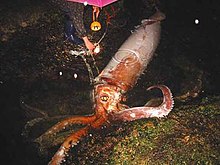
The first image of a live mature giant squid was taken on 15 January 2002, on Goshiki beach, Amino Cho, Kyoto Prefecture, Japan.[33][34][35][36][37] The animal, which measured about 2 m (6.6 ft) in mantle length and 4 m (13 ft) in total length,[34] was found near the water's surface. It was captured and tied to a quay, where it died overnight.[34] The specimen was identified by Koutarou Tsuchiya of the Tokyo University of Fisheries. It is on display at the National Science Museum of Japan.
First observations in the wild
The first photographs of a live giant squid in its natural habitat were taken on 30 September 2004, by Tsunemi Kubodera (National Science Museum of Japan) and Kyoichi Mori (Ogasawara Whale Watching Association).[2] Their teams had worked together for nearly two years to accomplish this. They used a five-ton fishing boat and only two crew members. The images were created on their third trip to a known sperm whale hunting ground 970 km (600 mi) south of Tokyo, where they had dropped a 900-m (3000-ft) line baited with squid and shrimp. The line also held a camera and a flash. After over 20 tries that day, an 8 m (26 ft) giant squid attacked the lure and snagged its tentacle. The camera took over 500 photos before the squid managed to break free after four hours. The squid's 5.5 m (18 ft) tentacle remained attached to the lure. Later DNA tests confirmed the animal as a giant squid.[2]
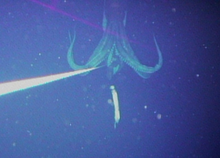
On 27 September 2005, Kubodera and Mori released the photographs to the world. The photo sequence, taken at a depth of 900 metres (3,000 ft) off Japan's Ogasawara Islands, shows the squid homing in on the baited line and enveloping it in "a ball of tentacles". The researchers were able to locate the likely general location of giant squid by closely tailing the movements of sperm whales. According to Kubodera, "we knew that they fed on the squid, and we knew when and how deep they dived, so we used them to lead us to the squid." Kubodera and Mori reported their observations in the journal Proceedings of the Royal Society.[2]
Among other things, the observations demonstrate actual hunting behaviors of adult Architeuthis, a subject on which there had been much speculation. The photographs showed an aggressive hunting pattern by the baited squid, leading to it impaling a tentacle on the bait ball's hooks. This may disprove the theory that the giant squid is a drifter which eats whatever floats by, rarely moving so as to conserve energy. It seems the species has a much more aggressive feeding technique.
First video of live adult
On 4 December 2006, an adult giant squid was caught on video near the Ogasawara Islands, 1,000 km (620 mi) south of Tokyo, by researchers from the National Science Museum of Japan led by Tsunemi Kubodera. It was a small female about 3.5 m (11 ft) long and weighing 50 kg (110 lb). The bait used by the scientists initially attracted a medium-sized squid measuring around 55 cm (22 in), which in turn attracted the giant squid. It was pulled aboard the research vessel, but died in the process.[38]
Cultural depictions
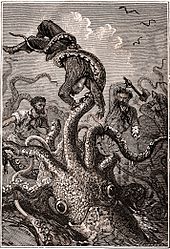
The elusive nature of the giant squid and its foreign appearance, often perceived as terrifying, have firmly established its place in the human imagination. Representations of the giant squid have been known from early legends of the kraken through books such as Moby-Dick and Twenty Thousand Leagues Under the Sea on to novels such as Ian Fleming's Dr. No and Peter Benchley's Beast (adapted as a film called The Beast) and modern animated television programs.
In particular, the image of a giant squid locked in battle with a sperm whale is a common one, although the squid is, in fact, the whale's prey, and not an equal combatant.
See also
- Gigantic octopus
- Humboldt squid
- Cthulhu, an alien creature with a cephalopod-like appearance from the H. P. Lovecraft story The Call of Cthulhu
- Watcher in the Water, a colossal, squid-like being in J. R. R. Tolkien's The Fellowship of the Ring
References
- ^ Anderton, H.J. 2007. Amazing specimen of world's largest squid in NZ. New Zealand Government website.
- ^ a b c d Kubodera, T. & K. Mori 2005. Template:PDFlink Proceedings of the Royal Society B: Biological Sciences, 272(1581):2583–2586.
- ^ de Pastino, Blake (December 22, 2006). "Photo in the News: Giant Squid Captured, Filmed for First Time". National Geographic News. Retrieved September 20, 2011.
- ^ Roeleveld, M.A.C. 2002. Tentacle morphology of the giant squid Architeuthis from the North Atlantic and Pacific Oceans. Bulletin of Marine Science 71(2): 725–737.
- ^ Young, R.E., M. Vecchione & K.M. Mangold 2001. Tentacular Club Variation in Cephalopods. Tree of Life web project.
- ^ Young, R.E., M. Vecchione & K.M. Mangold 2000. Cephalopod Tentacle Terminology. Tree of Life web project.
- ^ Piper, R. (2007). Extraordinary Animals: An Encyclopedia of Curious and Unusual Animals. Greenwood Press.
- ^ Eyden, P. 2004. Cretaceous Giant Squid. The Octopus News Magazine Online.
- ^ Tanabe, K., Y. Hikida & Y. Iba 2006. Two coleoid jaws from the Upper Cretaceous of Hokkaido, Japan. Journal of Paleontology 80(1): 138–145. doi:10.1666/0022-3360(2006)080[0138:TCJFTU2.0.CO;2]
- ^ Teichert, C. & B. Kümmel 1960. Size of Endocerid Cephalopods. Breviora Mus. Comp. Zool. 128: 1–7.
- ^ a b c d e f O'Shea, S. 2003. "Giant Squid and Colossal Squid Fact Sheet". The Octopus News Magazine Online.
- ^ Schrope, M. 2002. Giant Squid Babies Captured. Discovery News, February 27, 2002.
- ^ a b Bolstad, K.S. & S. O'Shea 2004. Template:PDFlink New Zealand Journal of Zoology 31: 15–21.
- ^ Soto, N.A., M.P. Johnson, P.T. Madsen, F. Díaz, I. Domínguez, A. Brito & P. Tyack 2008. Cheetahs of the deep sea: deep foraging sprints in short-finned pilot whales off Tenerife (Canary Islands). Journal of Animal Ecology doi:10.1111/j.1365-2656.2008.01393.x
- ^ Whales are 'cheetahs of the deep'. BBC News, May 14, 2008.
- ^ Cherel, Yves (January 2004). "Antarctic jaws: cephalopod prey of sharks in Kerguelen waters". Deep Sea Research Part I: Oceanographic Research Papers. 51 (1). Elsevier: 17–31. doi:10.1016/j.dsr.2003.09.009.
{{cite journal}}:|access-date=requires|url=(help); Unknown parameter|coauthors=ignored (|author=suggested) (help) - ^ Template:Es icon Guerra, Á., Á.F. González, F. Rocha, J. Gracia & L. Laria 2006. Enigmas de la Ciencia: El Calamar Gigante. CEPESMA, Vigo, Spain.
- ^ Roper, C.F.E. 1998. Architeuthidae Pfeffer 1900. Tree of Life web project.
- ^ Roper C.F.E., M.J. Sweeney & C.E. Nauen 1984. Cephalopods of the World. Food and Agriculture Organization, Rome, Italy.
- ^ Template:Ru icon Nesis, K.N. 1982. Abridged key to the cephalopod mollusks of the world's ocean. Light and Food Industry Publishing House, Moscow. 385+ii pp. [Translated into English by B.S. Levitov: L.A. Burgess (ed.) 1987. Cephalopods of the World. T.F.H. Publications, Neptune City, NJ. 351 pp.]
- ^ a b c d e Ellis, R. 1998. The Search for the Giant Squid. Lyons Press (London).
- ^ a b Norman, M.D. 2000. Cephalopods: A World Guide. ConchBooks.
- ^ Aristotle. N.d. Historia animalium.
- ^ Pliny. N.d. Naturalis historia.
- ^ The Search for the Giant Squid: Chapter One. The New York Times.
- ^ Jha, Alok (March 1, 2006). "Giant sea creature goes on display". The Guardian. London. Retrieved May 3, 2010.
{{cite news}}: Unknown parameter|foo=ignored (help) - ^ a b Holroyd, Jane (December 21, 2005). "New squid on the (ice) block". The Age. Melbourne, Australia. Retrieved August 31, 2010.
- ^ Giant squid goes on display. Natural History Museum, February 28, 2006.
- ^ Guerra, A., A.F. González & F. Rocha 2004. Template:PDFlink ICES Annual Science Conference September 22–25, 2004, Vigo, Spain.
- ^ Poppe, G.T. & Y. Goto. 1993. European Seashells. Hemmen.
- ^ Chasing Giants: On the Trail of the Giant Squid
- ^ O'Shea, S. 2003. Re: Living Architeuthis photo. The Octopus News Magazine Online.
- ^ O'Shea, S. 2003. Re: Living Architeuthis photo. The Octopus News Magazine Online.
- ^ a b c Template:Jp icon [Anonymous] 2002. 巨大イカ現れる !!. Kyoto Prefecture Web Site. (second page)
- ^ Template:Jp icon [Anonymous] 2006. 丹後の海の生き物(ダイオウイカ). Kyoto Prefecture Web Site, December 13, 2006.
- ^ Template:Jp icon [Anonymous] 2008. ダイオウイカが舞鶴市神崎海岸に漂着しました. Kyoto Prefecture Web Site, January 2008.
- ^ Template:Jp icon [Anonymous] 2008. ダイオウイカを標本に: 国立科学博物館が制作、舞鶴の砂浜に漂着. Kyoto Shimbun, February 8, 2008.
- ^ "Giant squid caught on video by Japanese scientists". Reuters. December 22, 2006.
Further reading
- National Geographic Video: "Sea Monsters"
- Aldrich, F.A. & E.L. Brown 1967. The Giant Squid in Newfoundland. The Newfoundland Quarterly. Vol. LXV No. 3. p. 4–8.
- "New giant squid predator found". BBC News. January 8, 2004. Retrieved October 6, 2005.
- Holroyd, J. New squid on the (ice) block, The Age, December 21, 2005.
- Grann, D. The Squid Hunter. New Yorker, May 24, 2004.
- Foxnews.com: "New giant squid predator found". Fox News. December 22, 2006. Retrieved December 22, 2006.
- BBC.co.uk: "New giant squid predator found". BBC News. January 15, 2003. Retrieved January 4, 2010.
External links
- CephBase: Architeuthis
- Tree of Life Web Project: Architeuthis
- TONMO.com's fact sheet for giant and colossal squids
- TONMO.com's giant squid reproduction article
- Giant Squid – Smithsonian Ocean Portal
- New Zealand – 1999 Expedition Journals In Search of Giant Squid
- Fishermen haul in world's biggest squid in the Ross Sea, February 2007.
